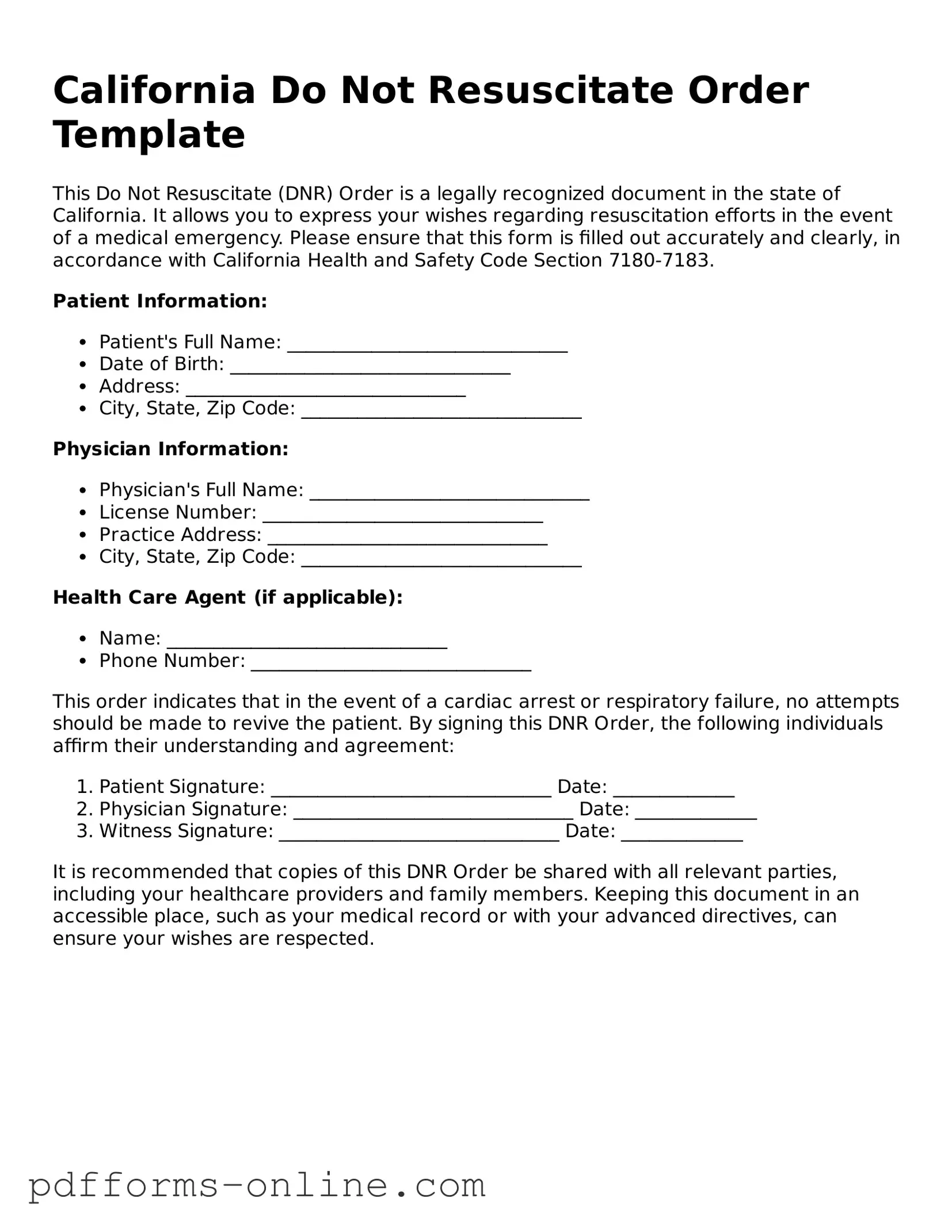The Advance Healthcare Directive is a crucial document that allows individuals to outline their healthcare preferences in advance. Similar to the California Do Not Resuscitate Order (DNR), it enables people to express their wishes regarding medical treatment if they become unable to communicate. This directive can include preferences about life-sustaining treatments, organ donation, and appointing a healthcare agent to make decisions on their behalf. Both documents serve to ensure that a person's healthcare choices are respected, even when they cannot voice them directly.
The Physician Orders for Life-Sustaining Treatment (POLST) form is another important document that shares similarities with the DNR. POLST is designed for individuals with serious health conditions and translates their treatment preferences into actionable medical orders. Like the DNR, it specifically addresses the use of resuscitation and other life-sustaining measures. The POLST form is intended to be more detailed than a DNR, often including preferences about various treatments, making it a valuable tool for emergency responders and healthcare providers.
The Living Will is a document that allows individuals to specify their preferences for medical treatment in the event they become incapacitated. Similar to a DNR, a Living Will communicates the types of medical interventions a person does or does not want. While the DNR focuses specifically on resuscitation efforts, the Living Will encompasses a broader range of medical decisions. Both documents aim to provide clarity and ensure that healthcare providers honor the patient's wishes.
The Healthcare Proxy is a legal document that designates someone to make healthcare decisions on behalf of an individual if they are unable to do so. Like the DNR, it emphasizes the importance of respecting a person's wishes regarding medical treatment. While the DNR provides specific instructions about resuscitation, the Healthcare Proxy empowers a trusted individual to interpret and act upon the patient's broader healthcare preferences. This relationship can be crucial in ensuring that the person’s values and desires are upheld during medical crises.
The Do Not Intubate (DNI) order is another document that is closely related to the DNR. A DNI order specifically instructs healthcare providers not to place a patient on a ventilator if they are unable to breathe on their own. This document complements the DNR by providing clarity on the patient's wishes regarding mechanical ventilation. Both documents reflect a patient’s desire to avoid aggressive life-sustaining treatments and focus on comfort and quality of life.
The Medical Power of Attorney (MPOA) grants an individual the authority to make medical decisions on behalf of another person. Like the DNR, it ensures that a person's healthcare preferences are respected. The MPOA can cover a wide range of medical decisions, while the DNR specifically addresses resuscitation. Both documents work together to provide a comprehensive approach to healthcare decision-making, ensuring that a patient's wishes are honored, even in challenging situations.
The Comfort Care Order is a document that outlines a patient's desire for comfort-focused care rather than aggressive treatment. Similar to the DNR, it emphasizes the importance of prioritizing the patient's quality of life. The Comfort Care Order specifies that, in the event of a medical emergency, the focus should be on alleviating pain and discomfort rather than prolonging life through invasive procedures. Both documents reflect a compassionate approach to end-of-life care.
The New York Trailer Bill of Sale form is an essential legal document that facilitates the sale and transfer of trailer ownership within New York State. To avoid any ambiguities during this process, it is important for both buyers and sellers to be well-informed about the details outlined in this document, as it protects the rights of both parties involved. For more information about this form, you can visit https://documentonline.org/blank-new-york-trailer-bill-of-sale, which provides comprehensive insights into its usage and significance.
The Do Not Hospitalize (DNH) order is a document that expresses a patient’s preference to avoid hospitalization in certain circumstances. Like the DNR, it aims to honor the patient's wishes regarding medical interventions. The DNH order can be particularly important for individuals with terminal illnesses or advanced chronic conditions who wish to remain in a familiar environment, such as their home or a hospice setting. Both documents advocate for a patient-centered approach to healthcare decisions, ensuring that individuals receive the type of care they desire.
